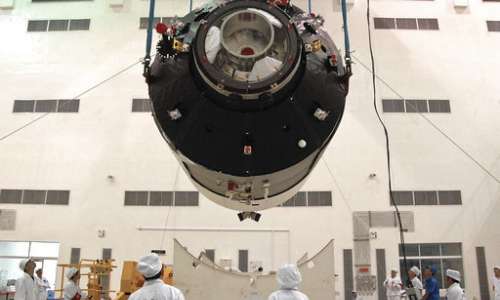China's defunct and reportedly out-of-control Tiangong 1 space station is expected to re-enter Earth's atmosphere sometime this weekend. It poses only a slight risk to people and property on the ground, since most of the bus-size, 8.5-ton vehicle is expected to burn up on re-entry, although space agencies don't know exactly when or where that will happen.
Below are some questions and answers about the station, its re-entry and the past and future of China's ambitious space program.
WHAT WILL HAPPEN AND HOW GREAT IS THE DANGER?
The European Space Agency predicts the station will re-enter the atmosphere between Saturday morning and Sunday afternoon—an estimate it calls "highly variable," likely because the ever-changing shape of the upper atmosphere affects the speed of objects falling into it.
The Chinese space agency's latest estimate puts re-entry between Saturday and Wednesday.
Western space experts say they believe China has lost control of the station. China's chief space laboratory designer Zhu Zongpeng has denied Tiangong was out of control, but hasn't provided specifics on what, if anything, China is doing to guide the craft's re-entry.
Based on Tiangong 1's orbit, it will come to Earth somewhere between latitudes of 43 degrees north and 43 degrees south, or roughly somewhere over most of the United States, China, Africa, southern Europe, Australia and South America. Out of range are Russia, Canada and northern Europe.
China's defunct space lab hurtling toward Earth for re-entry
This undated file photo shows researchers installing China's first space station module Tiangong-1 at the Jiuquan Satellite Launch Center in northwest China's Gansu Province prior to its launch on Sept. 29, 2011. China's defunct and believed out-of-control Tiangong 1 space station is expected to re-enter Earth's atmosphere sometime in the coming days, although the risk to people and property on the ground is considered low. (Color China Photo via AP, File)
Based on its size, only about 10 percent of the spacecraft will likely survive being burned up on re-entry, mainly its heavier components such as its engines. The chances of anyone person on Earth being hit by debris is considered less than one in a trillion.
Ren Guoqiang, China's defense ministry spokesman, told reporters Thursday that Beijing has been briefing the United Nations and the international community about Tiangong 1's re-entry through multiple channels.
HOW COMMON IS MAN-MADE SPACE DEBRIS?
Debris from satellites, space launches and the International Space Station enters the atmosphere every few months, but only one person is known to have been hit by any of it: American woman Lottie Williams, who was struck but not injured by a falling piece of a U.S. Delta II rocket while exercising in an Oklahoma park in 1997.
China's defunct space lab hurtling toward Earth for re-entry
In this June 18, 2012, file image released by China's Xinhua News Agency, Chinese astronauts, from left, Liu Wang, Liu Yang and Jing Haipeng wave while aboard the orbiting Tiangong-1 space station. China's defunct and believed out-of-control Tiangong 1 space station is expected to re-enter Earth's atmosphere sometime in the coming days, although the risk to people and property on the ground is considered low. (Beijing Aerospace Control Center/Xinhua via AP)
Most famously, America's 77-ton Skylab crashed through the atmosphere in 1979, spreading pieces of wreckage near the southwestern Australia city of Perth, which fined the U.S. $400 for littering.

Hi! I am a robot. I just upvoted you! I found similar content that readers might be interested in:
https://abcnews.go.com/Technology/wireStory/chinas-defunct-space-lab-hurtling-earth-entry-54088824
Downvoting a post can decrease pending rewards and make it less visible. Common reasons:
Submit
Lets talk about it
Downvoting a post can decrease pending rewards and make it less visible. Common reasons:
Submit